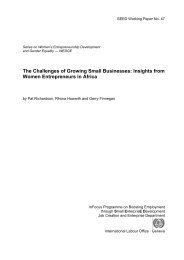manual: women workers' rights and gender equality - International ...
manual: women workers' rights and gender equality - International ...
manual: women workers' rights and gender equality - International ...
Create successful ePaper yourself
Turn your PDF publications into a flip-book with our unique Google optimized e-Paper software.
• Explain the meaning of the 4 colours:<br />
green = working hours<br />
yellow = rest period during work <strong>and</strong> leisure time after work<br />
red = household activities like cooking, shopping <strong>and</strong> washing clothes<br />
blue = sleeping<br />
• Give them 15 minutes to discuss <strong>and</strong> complete the clock<br />
Step 2<br />
• Compare <strong>and</strong> discuss the results of the 4 groups in plenary using the following questions<br />
- Are there any differences between the groups in terms of working hours?<br />
- If so, what are the main differences?<br />
- Why are these differences there?<br />
- Is this fair?<br />
- Are there any differences between the groups in terms of time spent on household<br />
activities?<br />
- If so, what are the main differences?<br />
- Why are these differences there?<br />
- Is this fair?<br />
- Are there any differences between the groups in terms of leisure time?<br />
- If so, what are the main differences?<br />
- Why are these differences there?<br />
- Is this fair?<br />
Step 3<br />
• Count the green ‘hours’ in the clock<br />
• Ask the groups if this is the same for all days<br />
• Compare the number of working hours with the official maximum of 8 hours for formal sector<br />
workers:<br />
- Do informal sector workers work more hours?<br />
- If yes, how many more?<br />
- What are the problems with working so many hours?<br />
- If not, why do they work less?<br />
Step 4<br />
• Ask the participants about their holidays (weekly <strong>and</strong> yearly):<br />
- Do they take a day off in a week?<br />
- If yes, when <strong>and</strong> why?<br />
- If not, why not?<br />
- Do they take some days off during the year?<br />
- If yes, when <strong>and</strong> why?<br />
- If not, why not?<br />
- What would they like as ideal situation?<br />
- Is that possible?<br />
- If yes, how?<br />
- If not, why not?<br />
Step 5<br />
• Summarize the things done <strong>and</strong> learned during this session<br />
Notes for the trainer<br />
After filling the clock the differences in activities are most probably as follows:<br />
- household activities: <strong>women</strong> do most of the household work<br />
97

















